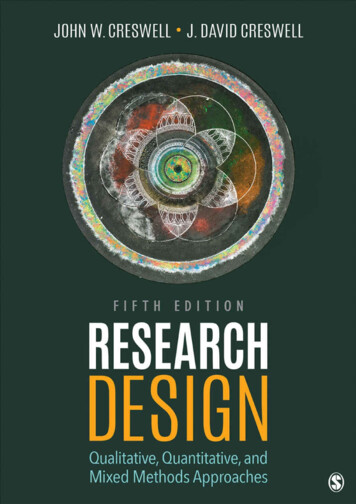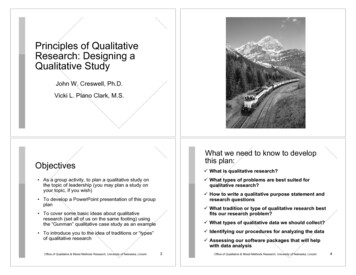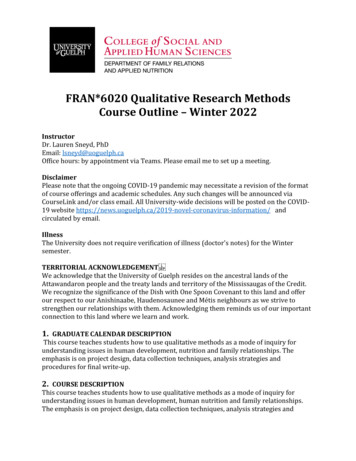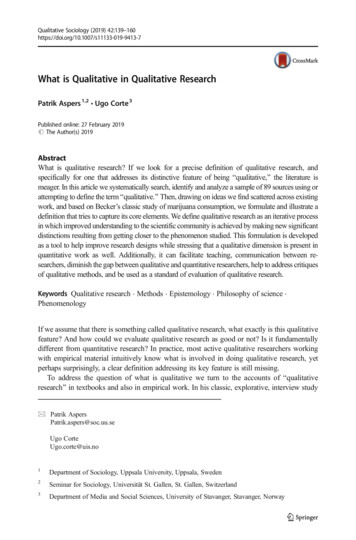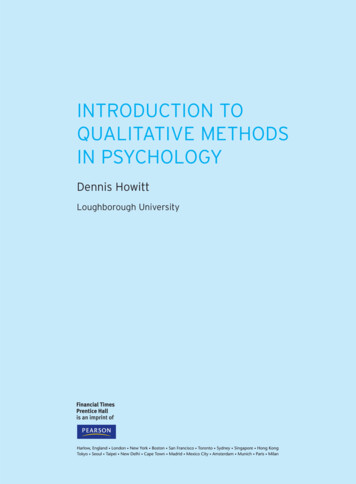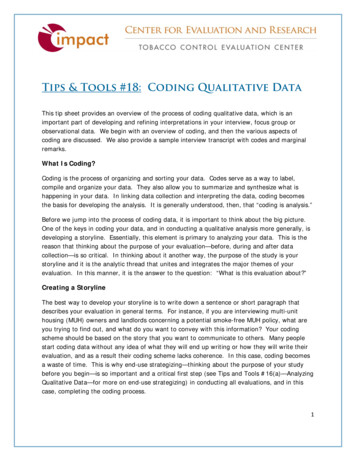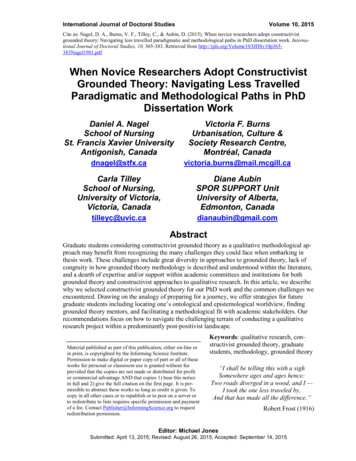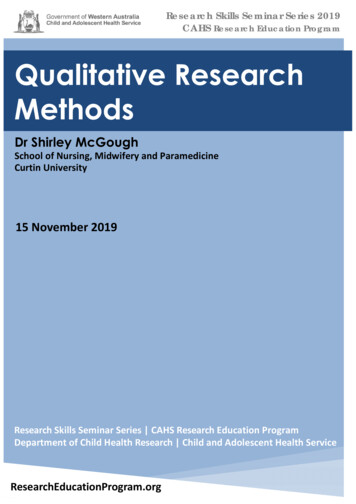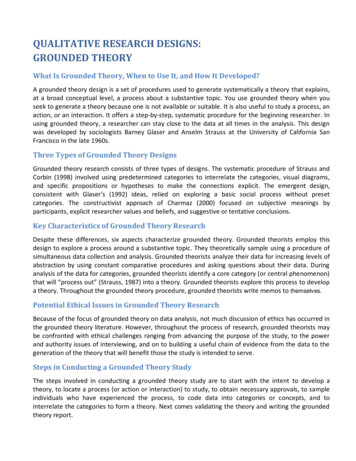
Transcription
QUALITATIVE RESEARCH DESIGNS:GROUNDED THEORYWhat Is Grounded Theory, When to Use It, and How It Developed?A grounded theory design is a set of procedures used to generate systematically a theory that explains,at a broad conceptual level, a process about a substantive topic. You use grounded theory when youseek to generate a theory because one is not available or suitable. It is also useful to study a process, anaction, or an interaction. It offers a step-by-step, systematic procedure for the beginning researcher. Inusing grounded theory, a researcher can stay close to the data at all times in the analysis. This designwas developed by sociologists Barney Glaser and Anselm Strauss at the University of California SanFrancisco in the late 1960s.Three Types of Grounded Theory DesignsGrounded theory research consists of three types of designs. The systematic procedure of Strauss andCorbin (1998) involved using predetermined categories to interrelate the categories, visual diagrams,and specific propositions or hypotheses to make the connections explicit. The emergent design,consistent with Glaser’s (1992) ideas, relied on exploring a basic social process without presetcategories. The constructivist approach of Charmaz (2000) focused on subjective meanings byparticipants, explicit researcher values and beliefs, and suggestive or tentative conclusions.Key Characteristics of Grounded Theory ResearchDespite these differences, six aspects characterize grounded theory. Grounded theorists employ thisdesign to explore a process around a substantive topic. They theoretically sample using a procedure ofsimultaneous data collection and analysis. Grounded theorists analyze their data for increasing levels ofabstraction by using constant comparative procedures and asking questions about their data. Duringanalysis of the data for categories, grounded theorists identify a core category (or central phenomenon)that will “process out” (Strauss, 1987) into a theory. Grounded theorists explore this process to developa theory. Throughout the grounded theory procedure, grounded theorists write memos to themselves.Potential Ethical Issues in Grounded Theory ResearchBecause of the focus of grounded theory on data analysis, not much discussion of ethics has occurred inthe grounded theory literature. However, throughout the process of research, grounded theorists maybe confronted with ethical challenges ranging from advancing the purpose of the study, to the powerand authority issues of interviewing, and on to building a useful chain of evidence from the data to thegeneration of the theory that will benefit those the study is intended to serve.Steps in Conducting a Grounded Theory StudyThe steps involved in conducting a grounded theory study are to start with the intent to develop atheory, to locate a process (or action or interaction) to study, to obtain necessary approvals, to sampleindividuals who have experienced the process, to code data into categories or concepts, and tointerrelate the categories to form a theory. Next comes validating the theory and writing the groundedtheory report.
Evaluating the Quality of a Grounded Theory StudySeveral published criteria exist for evaluating the quality of a grounded theory study. A good groundedtheory study presents a theory of a process grounded in the views of participants. This theory isdeveloped from the memos written by the researcher, the linking of concepts or categories, thepresentation of the theory as a visual model, and the use of systematic, emerging, or constructivistapproaches.USEFUL INFORMATION FOR PRODUCERS OF RESEARCH When planning a grounded theory study, use the steps for conducting a study advanced in thischapter.Consider whether your grounded theory study will be systematic, emergent, or constructivist.Make this decision based on reviewing the arguments for each design type and determiningwhether you prefer a more flexible or prescribed approach to grounded theory research.The visuals presented in this chapter can be adapted and used to display several processes andto create tables and diagrams, such as the zigzag data collection process and the constantcomparative approach.Creating a visual diagram of your theory helps to clearly identify the categories and see theirinterrelationships.Validate your theory by using constant comparative procedures, triangulating during theresearch, and by employing member checking with participants in your study.USEFUL INFORMATION FOR CONSUMERS OF RESEARCH Educators can use the criteria for evaluating a study to assess the quality of a published study.When examining a study to determine if it is a grounded theory project, you might look at thetitle to determine if the words “grounded theory” are included. Also, most grounded theoryprojects clearly include an exploration of a process, and the authors should identify this processin the purpose statement or research questions.A sign of grounded theory research is that the author employs multiple passes to the field tocollect data. A well-refined theory (and categories) consists of saturation and zigzagging back andforth between data collection and analysis to build the categories and theory.Look for a visual model of the theory. This model is the centerpiece of the grounded theory studyand represents the author’s attempt to visualize the process under study.ETHNOGRAPHIC RESEARCHDefining Ethnographic Research, Its Use, and Its DevelopmentAn ethnography is a useful design for studying groups in education, their behaviors, beliefs, andlanguage, and how they develop shared patterns of interacting over time. Ethnographic research is aqualitative design for describing, analyzing, and interpreting the patterns of a culture-sharing group. Cultureis a broad term used to encompass all human behavior and beliefs. Typically, it includes a study oflanguage, rituals, structures, life stages, interactions, and communication. Ethnographers visit the“field,” collect extensive data through such procedures as observation and interviewing, and write up a
cultural portrait of the group within its setting. Thus, ethnographers stress cultural concepts, and theystudy a group of individuals at a single site. The researcher examines shared patterns of behaviors,beliefs, and language that have developed over time by engaging in fieldwork such as observing andinterviewing people where they live and work. The analysis begins with describing and analyzing theculture-sharing group and interpreting their patterns within the context of culture-at-work. Overall, theethnographer employs a reflexive inquiry style of being self-conscious about the research and thewriting and being respectful of participants. The origins of this approach are found in anthropology,sociology, education, and postmodern, reflexive concerns about interpreting data and writing reports.Three Types of Ethnographic DesignsThese historical factors have led to three types of ethnographies: realist, case studies, and criticalstudies. A realist account is an objective account of a culture-sharing group. It is written in a thirdperson point of view, reports on the information learned from participants, and places the researcher inthe role of providing the final interpretation and presentation of the culture. Case studies focus on aprogram, event, or activities and provide a detailed description and analysis of a case based onextensive data collection. A critical ethnography is a type of ethnography in which the researchersadvocate for groups marginalized in our society and focus on issues such as power and authority.Potential Ethical Issues in Ethnographic ResearchEthical issues in ethnography relate to fieldwork concerns. These ethical issues involve such topics asgaining access to the field, staying in the field, gathering data in the field, and the interactions of beingin the field of research.Steps in Conducting an EthnographyThe steps in conducting these ethnographies involve starting with an interest in studying a culturaltheme, identifying a bounded site, and examining shared patterns for a group. The researcher posesgeneral research questions to identify shared patterns of behavior, beliefs, or language and also collectsextensive fieldwork data. From this data, a general portrait of how the culture-sharing group works isdeveloped through description, analysis, and interpretation. The interpretation and writing are sensitiveto the reflexivity of the researcher, and varied forms of writing structures are used.Conducting an ethnography involves clarifying the intent of the study, selecting an appropriate design,and relating the design to the research problem. Then the researcher needs to seek approval to conductthe study and obtain access to study sites and participants.Once this is accomplished, the ethnographer collects data using multiple sources of information andspends considerable time in the field. After gathering information, the analysis of data consists ofdescribing, analyzing, and interpreting. Some researchers, when conducting a critical ethnography, willidentify changes that need to occur and will actively advocate and plan for them. When writing the finalresearch report, ethnographers and case study writers employ practices consistent with their designs,such as being objective or advocative, generalizing findings, and discussing how they and theparticipants changed during the research process.Criteria for Evaluating an Ethnography StudyIn conducting a good ethnography, a researcher should pay attention to identifying a cultural issue tostudy, selecting a group to observe or interview over time, and noting shared patterns of behavior,language, and beliefs that the group has developed over time. The account needs to both describe the
group and identify themes. Moreover, the researchers need to provide evidence of being reflexive abouttheir role in the study.USEFUL INFORMATION FOR PRODUCERS OF RESEARCH Clarify the intent you have for your ethnographic research. Consider whether you plan todevelop patterns and a portrait of a culture-sharing group, provide an in-depth description andanalysis of a “case,” or advocate for an issue based on studying a culture-sharing group.Recognize that many ethnographies today are written using a critical perspective.If you conduct a case study, determine whether the issue (instrumental) or the case itself(intrinsic) is of primary interest for addressing your research problem.When conducting a realist ethnography, identify a cultural theme that you wish to explore. Thiscultural theme is the central phenomenon of your study.As you collect data in the field for a realist ethnography, look for shared patterns of behavior,beliefs, or language that develop over time.Engaging in fieldwork and collecting data involve negotiating relationships with participants andkey gatekeepers at research sites. Be respectful of sites and individuals as you conduct yourstudy.Consider in your ethnography how you will balance description of the culture sharing group orcase, analysis of themes about the group or case, and interpretation of the meaning of thedescription and analysis. Ideally, you should give them equal weight, but this would depend onthe purposes and the research questions you plan to address in your study.Context is important in ethnographies and case studies. Include it in your description as well as inyour themes.Authors write about how we interpret the “text,” or written report, in ethnographic research.Recognize and discuss in your report your own position that affects your interpretation, andacknowledge that multiple interpretations exist in any report, such as those of readers andparticipants in the study.Consider the steps in the process of conducting an ethnography and make adjustments in themto reflect the type of design you use. See Table 14.4 as a guide.USEFUL INFORMATION FOR CONSUMERS OF RESEARCH To identify the cultural theme in a realist ethnography, look at the purpose statement and theresearch question for the central phenomenon being examined.Recognize that the final ethnographic report or case study will vary in structure because of thedifferences among a realist ethnography, a case study, and a critical ethnography.Among several factors to use in evaluating an ethnography or case report, especially considerwhether the author collects multiple forms of data and spends considerable time in the fieldgathering information.The information researchers may report in an ethnography or case study may be insights fromexamining a portrait of a culture-sharing group, contributions to understanding cultural themes,
an in-depth exploration of a case that has not been examined before, or a plan for action tochange or remedy inequities in education and in our society.
NARRATIVE RESEARCHWhat Is Narrative Research, When Is It Used, and How Did It Develop?Narrative research has emerged as a popular form of qualitative research. It has become a viable way tostudy teachers, students, and educators in educational settings. All of these individuals have stories totell about their experiences. Narrative inquirers describe the lives of individuals, collect and tell storiesabout people’s lives, and write narratives of individual experiences. These qualitative studies focus onidentifying the experiences of a single individual or several individuals and understanding their past,present, and future experiences. A researcher uses narrative designs when individuals are willing toprovide their stories, when their stories follow a chronology.The Types of Narrative DesignsNarrative research is an overarching category for a variety of types of narrative studies. These may besuch types as autobiographies, biographies, life histories, and personal narratives of teachers orstudents. The specific type of narrative study depends on who writes or records the story, how much ofa life is recorded and presented, who provides the story, and whether a theory is used by theresearcher.The Key Characteristics of Narrative DesignsNarrative researchers collect stories from individuals and retell or restory the participants’ stories into aframework such as a chronology of the characters, the setting, the problem, the actions, and aresolution of those actions. In addition, the inquirer may gather field texts and form them into themesor categories and describe, in detail, the setting or context in which the stories are told. Throughout theresearch process, the researcher emphasizes collaboration between the researcher and the participant.Potential Ethical Issues in Gathering StoriesEthical issues may arise at many stages in the process of conducting a narrative study. At the datacollection stage, the researcher needs to question whether the story is authentic, determine whetherthe participants can tell (or recall) the real story, assess who owns the story told, determine if theparticipant’s voice is included in the final story, stage the project so that the participant, not theresearcher, gains as a result of the research, and be cognizant of the lasting impact of the story that istold.Steps in Conducting a Narrative StudyThe steps in conducting a narrative study are to identify a problem suited for narrative research and toselect one or more participants to study. Researchers then collect stories from the participant about hisor her life experiences and retell the story to form a chronology of events that may include thecharacters, setting, problem, actions, and resolution. Throughout this process, collaboration occurs withthe participant, and the story composed by the researcher tells of the participant’s life experiences.Evaluating a Narrative StudyA good narrative study reports the stories of lived experiences of an individual, organizes them into achronology, situates them within the setting or context, derives several themes that the stories address,
and demonstrates a close collaboration in the narrative project between the researcher and theparticipant.USEFUL INFORMATION FOR PRODUCERS OF RESEARCH Individuals planning or conducting a narrative study can employ the steps in the processidentified in this chapter.Consider the type of narrative design you plan to use. Ask yourself the following questions: Whowrites or records the story? How much of a life is recorded and presented? Who provides thestory? Is a theoretical lens being used? Can narrative forms be combined?The three steps used in restorying provide a structure for processing a transcript and developinga retelling of the participant’s story.As you listen to a participant’s story, consider some of the potential issues that may arise, suchas whether the story is authentic, whether data are distorted, whether individuals can tell thestory, and who owns the story.USEFUL INFORMATION FOR CONSUMERS OF RESEARCH Consumers can review the steps in the research process in this chapter to determine hownarrative inquirers conduct a study.The evaluation criteria discussed here can be used to assess the quality of a narrative study.When narrative researchers conduct an inquiry, they need to report that they have checked theaccuracy of their findings. Look for reports about triangulating data, member checking, orproviding disconfirming evidence for themes.The narrative journal article reported in this study provides one example of narrative research. Itis used to identify the major characteristics of a narrative study and to model the composition ofa narrative study.ACTION RESEARCHDefinition of Action Research, Its Use, and Its DevelopmentThe purpose of action research is to improve the practice of education, with researchers studying theirown problems or issues in a school or educational setting. Educators engage in reflection about theseproblems, collect and analyze data, and implement changes or a plan of action based on their findings.In some cases, the research solves a local, practical problem, such as a classroom issue for a teacher. Inother situations, the research seeks ideological aims, such as to empower, transform, and emancipateindividuals and communities.These projects focused on teachers studying their own practices, educators working with schools, andresearchers helping individuals emancipate themselves from social issues in educational settings. Today,action research has grown in importance as a means for enhancing school renewal, promoting teacherdevelopment, and testing new ideas.Types of Action Research DesignsAction research is an informal process of research in which educators engage in a study of their ownpractices. Individual teachers, teams within a school or district, or school– community inquiry groups
undertake this form of research. Two types of action research designs exist. The first design, practicalaction research, is an approach that involves educators examining a school situation with a view towardimproving practice. Rather than a focus on individual teachers solving immediate classroom problems orschools addressing internal issues, the second design, PAR (or critical action research), has a social andcommunity orientation and places emphasis on research that contributes to emancipation or change inour society. The PAR approach seeks to improve the quality of organizations, community, and familylives. It espouses an objective of improving and empowering individuals and organizations in educationalsettings. Both the practical and the participatory forms of action research have basic principles andmodels for conducting research.Key Characteristics of Action ResearchAction researchers use a process of inquiry, regardless of design. The teacher or educator becomes theresearcher. As the researcher, the practitioner becomes self-reflective about the process. Actionresearchers often engage others collaboratively in the process as co-participants and enact a dynamicmodel of inquiry involving iterations of activities, cycling back and forth between identifying a problem,trying a solution, reflecting on information learned, and applying new solutions. During this process,they use a plan of action to guide the use of a new practice. They base this plan on what they learnedabout the research problem, and they share it with others, such as in informal reports to colleagues,school officials, school boards, and community members.Potential Ethical Issues in Action ResearchEthical issues are central to conducting action research that involves participants in a substantial way.The action researcher needs to conduct the inquiry in a way that respects the care of the participants,involves them collaboratively in all phases of the research, and is sensitive to obtaining consent andadvancing the purpose of the study when all of the phases may not be initially known. It is alsoimportant for participants to have the option to withdraw from the study.Steps in Conducting an Action Research StudyAction researchers begin with a practical problem that they face or someone in a community might face.They help locate resources and information to address the problem, and they engage in data collectionthat might involve both quantitative and qualitative forms of data. They analyze the data, often donecollaboratively with participants, and develop and implement a plan of action.Evaluating an Action Research StudyEvaluation of an action research study is based on assessing whether it addresses a practical issue,involves the collection of multiple sources of data, proceeds with collaboration and respect forparticipants, advances a plan of action and, in the end, reflects both the researcher’s and theparticipants’ growth toward improved changes to practice.USEFUL INFORMATION FOR PRODUCERS OF RESEARCH Design an action research project that matches your time and resources.Recognize that the process of conducting an action research study is like a spiral with phases thatrepeat, such as looking, thinking, and acting, as in the Stringer (2007) model.Remember that in action research, you will be the participant in your own research project. Youare not studying someone else; instead, you are examining your own practices.
It is useful to collaborate with others in action research. Consider university personnel, othercolleagues, or individuals familiar with this form of research. They may have insight or be able todraw conclusions that you cannot draw.Collect data and analyze it so that it will be understandable to the applied audience for actionresearch studies in your school, district, or other educational unit.Consider the full array of data collection types for your action research, such as quantitative andqualitative data.Construct a plan of action that you can realistically carry out in your school or educationalsetting.USEFUL INFORMATION FOR CONSUMERS OF RESEARCH Recognize the differences between practical action research and PAR. The former has the intentof addressing a practical problem in education, whereas the latter has a social or communityorientation and emphasizes emancipation or change in our society.Action researchers study their own situation and attempt to develop solutions to practical (orcommunity) problems. When you review a study, identify the intent of the researcher and lookfor how the study addresses some issue in which the researcher is involved.Action research studies are applied and the results should be action oriented and easy tounderstand.Evaluate whether the action research study made a difference or changed the situationpresented in the research problem.MIXED METHODSMixed Methods Research, Its Use, and Its DevelopmentWith a better understanding of qualitative research and the advantages of collecting both quantitativeand qualitative data, mixed methods research designs are becoming popular in education. From initialmultimethod quantitative studies, designs have emerged that incorporate quantitative data (e.g., scoresfrom instruments, scores from observations, and census data) and qualitative data (e.g., open-endedinterviews, observations, documents, and visual materials). Today, writers talk about a separate designin education—the mixed methods design—in which investigators collect and analyze at least onequantitative method of data and one qualitative method of data, with attention to sequence andpriority. A mixed methods design involves the collection, analysis, and “mixing” of both quantitative andqualitative data to best understand a research problem.Types of Mixed Methods DesignsFour basic types of mixed methods designs exist. The convergent design includes the collection of bothquantitative and qualitative data simultaneously, with the purpose of merging or integrating the data.The explanatory design begins with quantitative data collection and analysis followed by qualitative datacollection and analysis. In this way, the researcher follows up on quantitative findings with qualitativeexplorations. The exploratory design reverses the data collection procedure. The mixed methodsresearcher first gathers qualitative data and then builds on the analysis of it using quantitative data. Theembedded design includes collecting a primary form of data and then a secondary form of data that
plays a supportive role in the study. Both forms of data are often collected simultaneously. In addition,more complex mixed methods designs are becoming more frequently used in this form of inquiry. Thetransformative design employs the use of a theoretical framework (e.g., feminist research) as anorienting lens for the entire study. The specific mixed methods designs within this framework can be anyof the four basic designs or combinations of them. The multiphase design is a mixed methods projectconducted over time using multiple phases or projects that build on each other. Any combination of thefour basic mixed methods designs can be used.Key Characteristics of Mixed Methods ResearchA major characteristic of mixed methods designs is a need to justify or provide a rationale for mixingmethods. Researchers also collect both quantitative and qualitative data and provide a priority to oneform of the data or the other, and they often sequence collecting both forms of data. Data analysisneeds to relate to the type of design, and this analysis may involve such data analysis approaches astransforming data, following up or explaining outlier or extreme cases, or using qualitative themes todevelop a quantitative instrument.Potential Ethical Issues in Mixed Methods ResearchEthical issues are becoming part of the conversation for mixed methods research. The most discussionhas been written about ethical issues in using a transformative design, and these issues focus onrespecting individuals and underrepresented groups. Ethics in mixed methods does need to relate toimportant issues arising in both quantitative and qualitative research. Moreover, they can relate tomixed methods designs because different types of design raise specific ethical issues that need to beanticipated by the researcher.Steps Used in Conducting Mixed Methods ResearchThe steps in conducting a mixed methods design involve assessing the feasibility of the study andpresenting a rationale for mixing methods. They also involve making decisions about the priority andsequence of the analysis and developing research questions for the study. Researchers then collect bothquantitative and qualitative data and analyze them together or separately (or both), depending on thedesign. The final research report may present the study as one phase or as two phases, based on theresearch design chosen for the project.Evaluating a Mixed Methods StudyEvaluating a mixed methods study means using mixed methods when it is appropriate, collecting bothqualitative and quantitative data, and integrating or combining the two forms of data. The methodsused for the qualitative and quantitative procedures need to be rigorous and persuasive. Part of thisdetail requires framing the study within one of the designs, and presenting a diagram of the procedures.Finally, throughout the project, researchers should use appropriate terms and language of mixedmethods research.USEFUL INFORMATION FOR PRODUCERS OF RESEARCH When presenting your mixed methods research to others, discuss your design as a distinct designin educational research.In the design of a mixed methods study, identify the advantages that will accrue from collectingboth quantitative and qualitative data. Let these advantages point you toward the most
appropriate design (e.g., convergent, explanatory, exploratory, embedded, transformative,multiphase) to study your research problem. In this chapter, the advantages of each design arespecified.Of the designs, recognize that it is easier to conduct a sequential explanatory or exploratorydesign than a convergent design. With a convergent design, you need to merge both quantitativeand qualitative databases (e.g., numbers and text) and possibly collect additional data if the twodatabases are in conflict.Recognize that in selecting a mixed methods design you have taken on a challenging project.Mixed methods research involves extensive data collection and data analysis. Weigh the tradeoff between drawbacks of time and resources and the advantages of collecting both quantitativeand qualitative data to understand your research problem.Use the two factors, priority and sequence, to help you decide what mixed methods researchdesign is appropriate for your study.To best present the procedures in your mixed methods design, create a diagram that portraysthe steps in the process. Use the guidelines about notation introduced in this chapter to help youdesign this visual.USEFUL INFORMATION FOR CONSUMERS OF RESEARCH Because researchers have only recently identified mixed methods as a specific design ineducational research, authors of studies may not label their research as mixed methods(although this is becoming more freq
QUALITATIVE RESEARCH DESIGNS: GROUNDED THEORY What Is Grounded Theory, When to Use It, and How It Developed? A grounded theory design is a set of procedures used to generate systematically a theory that explains, at a broad conceptual level, a process ab
